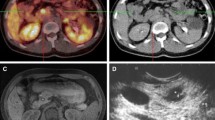Abstract
Purpose
To evaluate the impact of Ga-68 DOTATOC PET/CT on diagnosis and therapeutic management of patients with multiple endocrine neoplasia (MEN).
Materials and methods
We did 28 Ga-68 DOTATOC PET/CT in 21 MEN patients (10 female, 11 men; mean age 41.3 years). 109 lesions detected were classified into MEN-associated lesions [i.e., neuroendocrine tumors (NET)] and non-MEN-associated lesions for PET, CT, and PET/CT. The impact of Ga-68 DOTATOC PET/CT on diagnosis and therapeutic management of patients with MEN were assessed by the records of the interdisciplinary NET tumor board including histopathological findings, clinical and radiological follow-up.
Results
Ga-68 DOTATOC PET/CT had an impact on diagnosis and therapeutic management in 10/21 (47.6 %) MEN patients. For detecting NET lesions in MEN patients Ga-68 DOTATOC PET/CT reached a sensitivity/specificity of 91.7 %/93.5 %. There was a significant difference for the detection rate between Ga-68 DOTATOC PET/CT and CT alone (p < 0.001) both using contrast-agent (p = 0.002) or not (p < 0.001) and also a significant difference between contrast-enhanced (CE-) CT and non-CE-CT alone (p = 0.006).
Conclusions
GA-68 DOTATOC PET/CT allows a high detection rate of NET lesions in the context of MEN-1 syndrome as well as influence therapeutic management in nearly up to half of the patients. GA-68 DOTATOC PET/CT should include a CE-CT to improve MEN-associated NET lesion detection.



Similar content being viewed by others
References
Marini F, Falchetti A, Del Monte F, Carbonell Sala S, Gozzini A, Luzi E, et al. Multiple endocrine neoplasia type 1. Orphanet J Rare Dis. 2006;2:1–38.
Schussheim DH, Skarulis MC, Agarwal SK, Simonds WF, Burns AL, Spiegel AM, et al. Multiple endocrine neoplasia type 1: new clinical and basic findings. Trends Endocrinol Metab. 2001;12:173–8.
Iler MA, King DR, Ginn-Pease ME, O’Dorisio TM, Sotos JF. Multiple endocrine neoplasia type 2A: a 25-year review. J Pediatr Surg. 1999;34:92–6.
Raue F, Frank-Raue K. Update multiple endocrine neoplasia type 2. Fam Cancer. 2010;9:449–57.
Georgitsi M. MEN-4 and other multiple endocrine neoplasias due to cyclin-dependent kinase inhibitors (p27(Kip1) and p18(INK4C)) mutations. Best Pract Res Clin Endocrinol Metab. 2010;24:425–37.
Pacak K, Eisenhofer G, Goldstein DS. Functional imaging of endocrine tumors: role of positron emission tomography. Endocr Rev. 2004;25:568–80.
Ruf J, Heuck F, Schiefer J, Denecke T, Elgeti F, Pascher A, et al. Impact of Multiphase 68 Ga-DOTATOC-PET/CT on therapy management in patients with neuroendocrine tumors. Neuroendocrinology. 2010;91:101–9.
Brandi ML, Gagel RF, Angeli A, Bilezikian JP, Beck-Peccoz P, Bordi C, et al. Guidelines for diagnosis and therapy of MEN type 1 and type 2. J Clin Endocrinol Metab. 2001;86:5658–71.
Zhernosekov KP, Filosofov DV, Baum RP, Aschoff P, Bihl H, Razbash AA, et al. Processing of generator-produced 68 Ga for medical application. J Nucl Med. 2007;48:1741–8.
Breeman WA, de Jong M, de Blois E, Bernard BF, Konijnenberg M, Krenning EP. Radiolabelling DOTA-peptides with 68 Ga. Eur J Nucl Med Mol Imaging. 2005;32:478–85.
Pfannenberg C, Schraml C, Schwenzer N, Werner M, Muller M, Bares R, et al. Comparison of [68 Ga]DOTATOC-PET/CT and whole-body MRI in staging of neuroendocrine tumors. Cancer Imaging. 2011;11:38–9.
Paulson EK, McDermott VG, Keogan MT, DeLong DM, Frederick MG, Nelson RC. Carcinoid metastases to the liver: role of triple-phase helical CT. Radiology. 1998;206:143–50.
Caplin M, Sundin A, Nillson O, Baum RP, Klose KJ, Kelestimur F, et al. ENETS Consensus Guidelines for the management of patients with digestive neuroendocrine neoplasms: colorectal neuroendocrine neoplasms. Neuroendocrinology. 2012;95:88–97.
Pelage JP, Soyer P, Boudiaf M, Brocheriou-Spelle I, Dufresne AC, Coumbaras J, et al. Carcinoid tumors of the abdomen: CT features. Abdom Imaging. 1999;24:240–5.
Ruf J, Schiefer J, Furth C, Kosiek O, Kropf S, Heuck F, et al. 68 Ga-DOTATOC PET/CT of neuroendocrine tumors: spotlight on the CT phases of a triple-phase protocol. J Nucl Med. 2011;52:697–704.
Mayerhoefer ME, Schuetz M, Magnaldi S, Weber M, Trattnig S, Karanikas G. Are contrast media required for (68)Ga-DOTATOC PET/CT in patients with neuroendocrine tumours of the abdomen? Eur Radiol. 2012;22:938–46.
Pasquali C, Rubello D, Sperti C, Gasparoni P, Liessi G, Chierichetti F, et al. Neuroendocrine tumor imaging: can 18F-fluorodeoxyglucose positron emission tomography detect tumors with poor prognosis and aggressive behavior? World J Surg. 1998;22:588–92.
Marzola MC, Pelizzo MR, Ferdeghini M, Toniato A, Massaro A, Ambrosini V, et al. Dual PET/CT with (18)F-DOPA and (18)F-FDG in metastatic medullary thyroid carcinoma and rapidly increasing calcitonin levels: comparison with conventional imaging. Eur J Surg Oncol. 2010;36:414–21.
Diehl M, Risse JH, Brandt-Mainz K, Dietlein M, Bohuslavizki KH, Matheja P, et al. Fluorine-18 fluorodeoxyglucose positron emission tomography in medullary thyroid cancer: results of a multicentre study. E Eur J Nucl Med. 2001;28:1671–6.
Szakall S Jr, Esik O, Bajzik G, Repa I, Dabasi G, Sinkovics I, et al. 18F-FDG PET detection of lymph node metastases in medullary thyroid carcinoma. J Nucl Med. 2002;43:66–71.
Weber T, Cammerer G, Schick C, Solbach C, Hillenbrand A, Barth TF, et al. C-11 methionine positron emission tomography/computed tomography localizes parathyroid adenomas in primary hyperparathyroidism. Horm Metab Res. 2010;42:209–14.
Li S, Beheshti M. The radionuclide molecular imaging and therapy of neuroendocrine tumors. Curr Cancer Drug Targets. 2005;5:139–48.
Author information
Authors and Affiliations
Corresponding author
Rights and permissions
About this article
Cite this article
Froeling, V., Elgeti, F., Maurer, M.H. et al. Impact of Ga-68 DOTATOC PET/CT on the diagnosis and treatment of patients with multiple endocrine neoplasia. Ann Nucl Med 26, 738–743 (2012). https://doi.org/10.1007/s12149-012-0634-z
Received:
Accepted:
Published:
Issue Date:
DOI: https://doi.org/10.1007/s12149-012-0634-z




